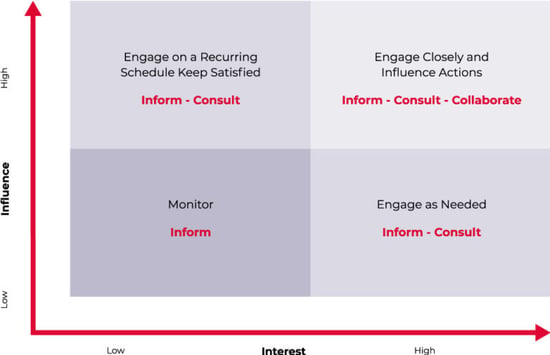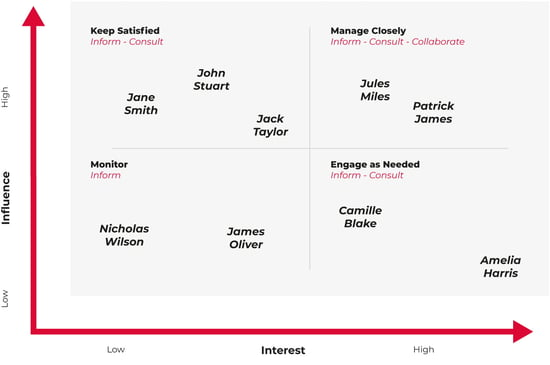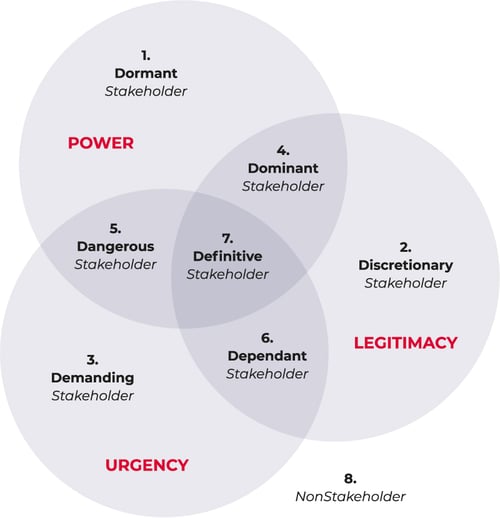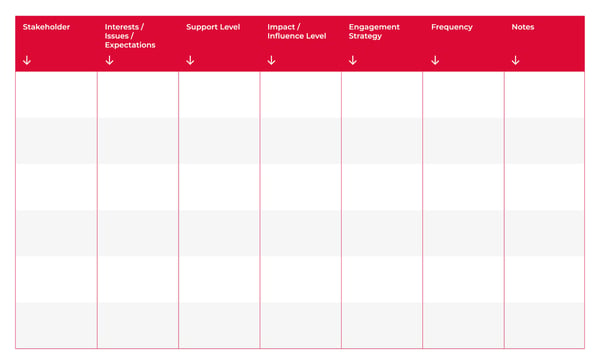Stakeholder analysis is one of the key steps to establishing support when starting a project.
Every project has individuals who have some sort of interest or will be influenced by it - the project stakeholders. Failing to engage with them can have a direct influence on the project’s outcomes.
To be able to engage with them successfully, you need to know exactly who they are, and that's when stakeholder analysis comes in place.
In this post you’ll learn all you need to know about stakeholder analysis:
- What is stakeholder analysis?
- The importance of stakeholder analysis
- Stakeholder analysis in project management
- How to do stakeholder analysis?
- Stakeholder analysis template and tools
What is stakeholder analysis?
Stakeholder analysis is the process of identifying and collecting information about individuals or groups impacted by or able to influence your project.
Modern stakeholder analysis increasingly involves co-creation, where stakeholders actively participate in shaping project goals and outcomes, and digital tools that streamline communication and engagement.
Conducting a stakeholder analysis will enable you to identify all your stakeholders as well as their needs and expectations.
The importance of stakeholder analysis
Every stakeholder will have a unique view of your project and different perceptions about the change it is supposed to bring.
Stakeholder analysis helps you discover what your stakeholders need and expect from your project. It allows you to identify key stakeholders, the ones with a positive attitude towards your project and those who might oppose it.
With this information, you can plan different strategies and choose the best types of communication to engage with them based on the value they see in the project. You’ll keep your supporters as contributors and help the resistant ones gain positive attitudes towards the change.
Your work will be more productive, as you will know where to allocate time and effort properly and proactively address any potential risks or issues identified.
Benefits from analysing stakeholders
Here are a few of the benefits of conducting a stakeholder analysis:
- Being inclusive
By identifying and analysing your stakeholders, you obtain a clear picture of who they are and ensure all those who are impacted by your project are considered. - Engaging effectively
Grouping your stakeholders based on your analysis allows you to plan targeted communications for each group, increasing your chances of positive engagement. - Promoting understanding and alignment
Creating communication channels facilitates stakeholders' understanding of the project goal and its benefits, builds trust, and helps the project get support. - Anticipating issues
Knowing your stakeholders helps you plan actions, avoiding potential problems that could hurt the project underway. - Gaining insights
Your key stakeholders may share relevant opinions and views with you, which you can use to improve the project (and as an additional benefit, gain more of their support). - Building trust
Stakeholders today expect transparency and alignment with ESG goals. By integrating stakeholder feedback into project strategies, you demonstrate accountability and gain long-term support.
Stakeholder analysis in project management
Projects that lack engagement with the people who can influence their outcomes can struggle.
If your project is already in motion and is facing some trouble, stakeholder analysis is a great tool to reassess issues so you can establish the best course of action on how to tackle them.
However, the best way to avoid issues and even project failure in the first place is to get your stakeholders involved in the early stages of your project. And that process starts with analysing your stakeholders.
Stakeholder analysis is not supposed to be a one-time process, especially if your project is long. People’s interest in a project can change, and new stakeholders may be identified in a second analysis conducted six months after the first one (that you would otherwise overlook).
Consider the duration of your project to stipulate how frequently you should conduct a new stakeholder analysis.
How to do a stakeholder analysis?
Analysing stakeholders consists of three parts: identify, categorise and prioritise.
Once your stakeholder analysis is complete, you will have the necessary understanding of your stakeholders to plan your communications in a stakeholder engagement plan.
Let’s go over each step:
1. Stakeholder identification
To analyse your stakeholders, you first must know who they are. Your project stakeholders will include anyone who’s impacted by your project, have an interest in it or can influence it.
Consider individuals, groups and organisations. Local communities, residents, partners, suppliers, government, media and your organisation’s employees, investors and clients.
Here are a few ideas you can use to identify stakeholders:
- Brainstorm sessions with your team and also other departments;
- Check past projects from your company and look for their contacts data;
- Ask other departments about their current projects and consider their stakeholders;
- Research the market for the same type of project where you may be able to identify their stakeholders.
Your stakeholders will have a multitude of motivations that connect them with your project in different ways. Focus on learning about these motivations and identifying their interests with your stakeholders’ perspective in mind, not yours.
Consider age, location, political opinion, religion, values, income, and financial and business interests as some of the factors that can influence how they see your project.
Asking your stakeholders about their expectations regarding the project and the benefits they see from the project’s completion will help you obtain a better level of understanding.
The more you learn about them, the better chances you have to provide them with relevant information that addresses their concerns.
After exhausting all your sources of information, you will likely have an extensive list of stakeholders to work with.
2. Stakeholder categorisation
Now that you have identified all your stakeholders, it’s time to categorise them.
The idea is to separate them into groups based on certain criteria, such as commonalities, interests or motivations.
The most common models used for this exercise are the Interest/Influence Matrix and the Salience Model:
The Interest/Influence Matrix
This matrix considers the levels of involvement and power your stakeholders have on your project to classify them into four different quadrants.

To every quadrant a stakeholder falls into, there’s a specific type and frequency of engagement that works best.
The interest/influence matrix is the model used to create a visual analysis of your stakeholders, the Stakeholder Mapping process.
Stakeholder Analysis example using the Interest/Influence Matrix:

The Salience Model
The Salience Model classifies stakeholders by attributing eight different stakeholder types. They are categorised considering the three parameters of power, legitimacy and urgency.

You can learn in more detail about both categorisation models and how to apply them in our Guide to categorising stakeholders.
Stakeholder types
Your stakeholders fit into one of the three stakeholder types:
- Key stakeholders
Those who have a high influence or importance on your project, and can have a direct impact on it. They can play an important role in the project’s outcomes. - Primary stakeholders
Stakeholders who are most affected by the project. They can either be positively or negatively impacted. - Secondary stakeholders
People or organisations who are indirectly affected by the project or its outcomes. They may have less interest in it, but still must be engaged.
3. Stakeholder prioritisation
The last part of your stakeholder analysis is to prioritise your stakeholders.
Since it’s likely you won’t be able to meet all needs at the same time, prioritising is a good strategy to get your engagement started.
Whether you used the Interest/Influence Matrix or the Salience Model to classify your stakeholders, you should have multiple stakeholder groups identified.
Think about how you can earn the support of each group. They will all require different types of engagement.
Use the three levels of stakeholder engagement - inform, consult and collaborate – to support your engagement plan. Each level has its own communication channels that work best to help you build a good relationship with your stakeholders.
Prioritising your stakeholder engagement will look different from one project to another, and it can also vary according to the time and resources you have available, among other factors. Also, keep in mind your stakeholders’ expectations and concerns when planning your engagement.
Now you should have all the necessary information to build a solid stakeholder engagement plan that will secure the support your project goals need.
Stakeholder analysis template
Here’s a stakeholder analysis template you can follow to keep track of your identified and assessed stakeholders:
Download your template copy here: 
Stakeholder analysis tools
You can use the stakeholder analysis template above or search for the many stakeholder analysis tools available online.
Word, Excel and PowerPoint templates will work for you as long as you are managing a small number of stakeholders and little data. But beyond these, tools like Tractivity offer dynamic dashboards for managing complex stakeholder data. These tools provide real-time insights and visual maps for better decision-making.
So if you’re dealing with a large number of people, consider a secure platform to manage their details. It will make your job a lot easier, more reliable and safer.
Streamline your stakeholder analysis
Stakeholder analysis is an essential piece of the stakeholder management puzzle.
It’s an effective way to understand your stakeholders and help them gain and maintain positive attitudes towards the change your project will bring.
A complete stakeholder analysis tool such as Tractivity allows you to add, analyse, map, understand and engage with all your stakeholders within a single system.
All your stakeholder data is kept safe, and you can easily check every engagement made, helping you stay on track with your stakeholder management to support your project.
Get in touch for a live preview of our stakeholder engagement system and discover a better way to analyse and engage with your stakeholders.

